Growing Mango Trees in Hot, Dry Climates
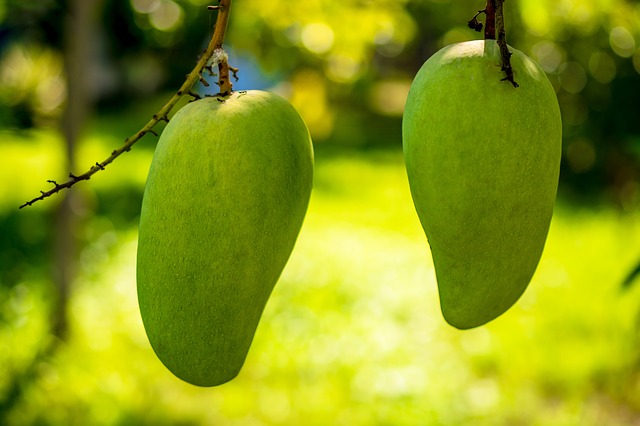
If you’ve never tried a fresh mango off the tree, you’re missing out. The stringy unripe mangos from Walmart just don’t cut it. Grocery stores have started to introduce some better quality mangos, but for the most part, they’re Tommy Atkins variety, which is a very average mango at best. Most mangos are shipped to the U.S. from other countries, so they’re picked under-ripe, and have to go through a boiling process to enter the U.S. If you disliked a grocery store mango, try ordering one from a Florida grower. Many of the Florida mango grower’s ship mangos when in season, so order some, and give them a chance. Mango is definitely my favorite tropical fruit. When I found out that people were growing mango trees in hot, dry climates, I had to try a tree for myself.
I’m growing a few different varieties listed below:
Keitt Mango

This is my favorite variety that can be found in the stores. It’s primarily a later season variety and tends to have a green skin.
I think the green skin can make it look unripe, but the skin can remain green on some varieties of mango even when ripe.
These are also grown on farms in Coachella Valley, which was my main interest in growing this tree. Coachella Valley is a desert climate, similar to my climate in the Phoenix, Arizona area.
I figured if they can have success growing this variety, it should also do well in my climate. This tree has a scraggly growth habit and doesn’t really grow upright like some varieties.
It’s growing at a moderate pace in my climate.
Gary Mango
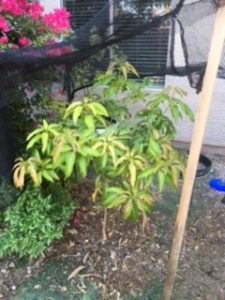
This is the youngest Mango tree that I have. I planted it as a 3-gallon tree in Oct 2017. My tree is growing steadily and I’m looking forward to trying the fruit from this tree.
It’s been able to push through at least one winter and summer in our extreme climate. I intend to allow it to focus on putting out growth for one more year before allowing it to fruit.
One of the challenges with getting a small grafted Mango tree is that they’ll want to flower and fruit immediately. Although it’s tempting to allow it to produce, the tree is still too small for fruit.
Even though it can be painful, it’s a good idea to cut the small fruits off the first year or two so the tree can put its energy into developing a root system and structure.
Carrie Mango
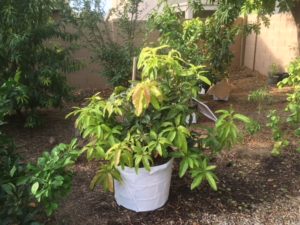
I had my first fruits off my Carrie Mango tree in summer 2018. I planted the tree in spring of 2016 and have been growing it in a container.
Carrie is somewhat of a dwarf variety, which makes it more suitable for container growing. Carrie has a reputation for being one of the best mango varieties out there.
It is a bit of a challenge to pick them at peak ripeness since it is more of a green-skinned variety.
These mangos almost melt in your mouth, they are so juicy and delicate. This tree seems to do really well in our climate and has been one of my more steady growers.
Itamaraca Red Mango
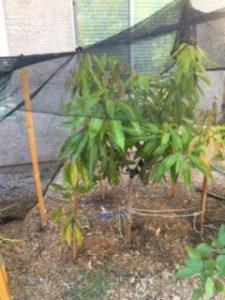
I purchased this mango tree at a local nursery as a starter seedling plant in Spring 2016. It was only about a foot tall when I planted it.
I grew it in a container until we moved into our current residence in Dec 2016, then planted it in the ground.
This tree has been my most vigorous growing mango. I believe that since it isn’t grafted, that has something to do with it.
It seems like it has handled our elements a little bit better than my other mango trees. This tree is my largest mango tree, even though it started out much smaller than my 3-gallon grafted trees purchased around the same time.
Check out my post here where I discuss growing fruit trees from seed. This tree didn’t flower in its first couple years.
This variety is pretty rare and I haven’t found too much info on it. I know that it is a Brazilian Mango and the fruits are smaller than a standard mango variety.
Fruit
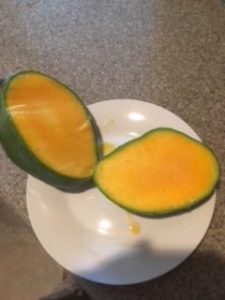
There are hundreds of Mango varieties with new ones being propagated all the time. Each mango has little subtleties in flavors that make it a pleasure to enjoy eating different varieties.
Some will have hints of coconut, while others have a taste like a pineapple, so no mango seems to be exactly alike.
One thing that most people appreciate are fiberless mangos. These types of mangos are smooth without that stringy flesh getting caught in your teeth.
I’ve learned that taste preferences for mangos can differ based on ones culture or place of origin.
Mangos that come from India have different flavor profiles, then mangos coming from Asia.
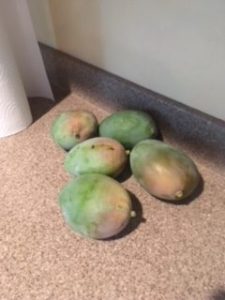
Gardening Skill Level
I would rate growing mangos in hot, dry areas to be a moderate skill level. Mangos love heat and warm weather.
When temps are extreme, like over triple digits, they can show signs of leaf burn, so they appreciate some shade or relief from intense summer sun.
The main challenge with growing Mangos are potential frosts. I’ve read that Mangos can take into the upper 20’s, but may incur some cold damage at this temps.
Anything below that will kill the tree. It’s important to have a plan for frost protection in marginal climates whether that’s container growing them or a means to protect them in the ground.
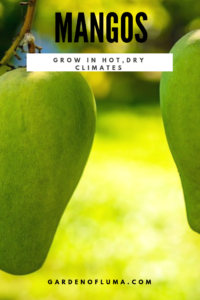
Suitable for Container Growing
Mango Trees can do quite well in containers. It helps in getting the right varieties that are more naturally dwarf, but in our marginal climate, you can pretty much grow any variety in containers.
Mango Trees can get huge in the tropical regions, but due to our climate conditions, it slows down the growth of the tree, keeping Mango Trees fairly small.
Some of the best dwarf varieties are Carrie, Pickering, Nam Doc Mai, Ice Cream, Julie, Fairchild, Angie, and Cogshall. Planting it in well-draining soil, like a cactus mix is essential.
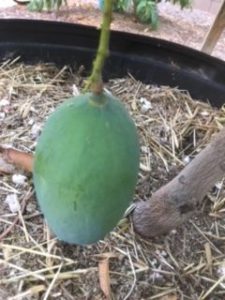
Planting Tips
Like most of the tropical fruit trees I’m growing, if planting in the ground, it’s important to think about where they will stay warmest in the winter.
So, planting them next to other trees or structures can help create warmth in the cooler months.
I wouldn’t worry too much about a Mango tree compromising structures in our climate since the weather conditions don’t allow them to grow into massive trees.
Watering
I give my mango plenty of water during the warm months of the year. I generally water my in-ground mangos every 3 days in the warm months or as the soil feels dry.
My container mango tree is watered a little bit more frequently. During the cooler months, I water a lot less, approximately every 1-2 weeks.
It’s good to let a slow drip run for a long time to water deeply into the soil.
With my more tropical fruit trees, taking into consideration how it rains frequently in the tropics, it’s hard to overwater them in the summer.
Although our clay soil retains a good amount of moisture, so it doesn’t need to be done daily.
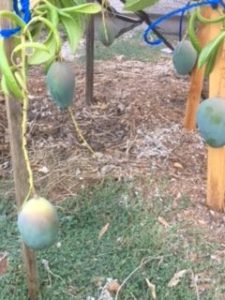
Feeding
I avoid synthetic fertilizers for my mango trees and stick with organics. I use fish emulsion and liquid seaweed as my primary means for fertilizing my mango trees.
Since mango trees are really affected by salt burn, which usually shows on the tips of the leaves, I choose to avoid fertilizers that could cause any additional salt burn.
I also periodically use chelated iron and Epsom salts, as well as compost. Folier feeding also helps get nutrients to the tree through the pores of the leaves.
Sun Exposure
Mango trees can take full sun in our climate but do better with some shade protection the first few years as they get established.
Our extreme sun can cause some leaf burn, but if properly cared for, the tree will be fine. Mango trees do like sun, so planting them in a really shady spot will hinder the growth of the tree.
Potential Problems
Salt burn is a problem with growing Mango trees in higher PH soils, like our desert clay. It’s important to periodically flush the salts from the soil by really soaking the area for a long period of time.
Using gypsum can also add in pulling the salts away from the tree. Since growing Mangos in the Arizona desert climate is relatively new, I’ve seen a lot of debate from local growers on some of the possible deficiencies or problems with mango trees.
Anthracnose is a common fungal disease to inflict mango trees in a humid climate and it’s up for debate if that’s a factor in dry climates.
It could be beneficial to periodically use a copper spray. Thrips can also be an issue with causing distorted leaves on young foliage, which neem oil can help.
Our mango leaves tend to have a yellowish look to them in the summer, possibly due to our intense sun or barriers to absorbing nutrients in our climate.
Please comment below on anything you enjoyed from this post or your experiences growing mango trees in hot, dry climates.

Hi,
I love your website. Thank you for the invaluable info. We love at 95070 and would love to grow mangoes and bananas and any other tropical fruit that can go in very large containers. Would love to get your recommendations.
Thank you in advance
Ami
Sounds like you’re in Northern California. Mangos would be a challenge in your area, due to lack of heat. Jaboticaba, Loquats, and Cherimoya would be good to try.
I liked your detailed post. I live near Thar desert in India. I want to grow Mango trees at my house’s boundary line. Temperature here sometimes goes 48 to 52 degree Celsius (118 to 125 F). And it will be near to my house’s boundary line so tree must have non invasive root. Can you help which type of mango trees will be the best “You can suggest other than mango trees too”.
Thanks
Do you have many mango trees in the desert regions of India? What varieties do well in the desert there?